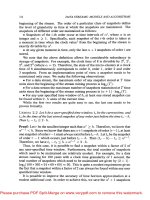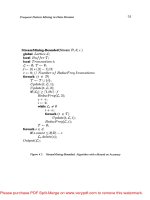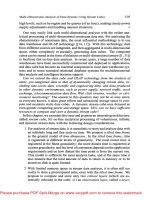Data Definition, Constraints, and Schema Changes potx
Bạn đang xem bản rút gọn của tài liệu. Xem và tải ngay bản đầy đủ của tài liệu tại đây (426.19 KB, 73 trang )
Slide 8- 1
Copyright © 2007 Ramez Elmasri and Shamkant B. Navathe
Data Definition, Constraints, and
Schema Changes
Used to CREATE, DROP, and ALTER the
descriptions of the tables (relations) of a
database
Slide 8- 2
Copyright © 2007 Ramez Elmasri and Shamkant B. Navathe
CREATE TABLE
Specifies a new base relation by giving it a name, and
specifying each of its attributes and their data types
(INTEGER, FLOAT, DECIMAL(i,j), CHAR(n),
VARCHAR(n))
A constraint NOT NULL may be specified on an attribute
CREATE TABLE DEPARTMENT (
DNAME VARCHAR(10) NOT
NULL,
DNUMBER INTEGER NOT NULL,
MGRSSN CHAR(9),
MGRSTARTDATE CHAR(9) );
Slide 8- 3
Copyright © 2007 Ramez Elmasri and Shamkant B. Navathe
CREATE TABLE
In SQL2, can use the CREATE TABLE command for specifying the primary
key attributes, secondary keys, and referential integrity constraints (foreign
keys).
Key attributes can be specified via the PRIMARY KEY and UNIQUE phrases
CREATE TABLE DEPT (
DNAME VARCHAR(10) NOT NULL,
DNUMBER INTEGER NOT NULL,
MGRSSN CHAR(9),
MGRSTARTDATE CHAR(9),
PRIMARY KEY (DNUMBER),
UNIQUE (DNAME),
FOREIGN KEY (MGRSSN) REFERENCES EMP );
Slide 8- 4
Copyright © 2007 Ramez Elmasri and Shamkant B. Navathe
DROP TABLE
Used to remove a relation (base table) and its
definition
The relation can no longer be used in queries,
updates, or any other commands since its
description no longer exists
Example:
DROP TABLE DEPENDENT;
Slide 8- 5
Copyright © 2007 Ramez Elmasri and Shamkant B. Navathe
ALTER TABLE
Used to add an attribute to one of the base
relations
The new attribute will have NULLs in all the tuples of
the relation right after the command is executed;
hence, the NOT NULL constraint is not allowed for
such an attribute
Example:
ALTER TABLE EMPLOYEE ADD JOB
VARCHAR(12);
The database users must still enter a value for
the new attribute JOB for each EMPLOYEE tuple.
This can be done using the UPDATE command.
Slide 8- 6
Copyright © 2007 Ramez Elmasri and Shamkant B. Navathe
Features Added in SQL2 and SQL-
99
Create schema
Referential integrity options
Slide 8- 7
Copyright © 2007 Ramez Elmasri and Shamkant B. Navathe
CREATE SCHEMA
Specifies a new database schema by giving it a
name
Slide 8- 8
Copyright © 2007 Ramez Elmasri and Shamkant B. Navathe
REFERENTIAL INTEGRITY
OPTIONS
We can specify RESTRICT, CASCADE, SET NULL or SET
DEFAULT on referential integrity constraints (foreign keys)
CREATE TABLE DEPT (
DNAME VARCHAR(10) NOT NULL,
DNUMBER INTEGER NOT NULL,
MGRSSN CHAR(9),
MGRSTARTDATE CHAR(9),
PRIMARY KEY (DNUMBER),
UNIQUE (DNAME),
FOREIGN KEY (MGRSSN) REFERENCES EMP
ON DELETE SET DEFAULT ON UPDATE
CASCADE);
Slide 8- 9
Copyright © 2007 Ramez Elmasri and Shamkant B. Navathe
REFERENTIAL INTEGRITY
OPTIONS (continued)
CREATE TABLE EMP(
ENAME VARCHAR(30) NOT NULL,
ESSN CHAR(9),
BDATE DATE,
DNO INTEGER DEFAULT 1,
SUPERSSN CHAR(9),
PRIMARY KEY (ESSN),
FOREIGN KEY (DNO) REFERENCES DEPT
ON DELETE SET DEFAULT ON UPDATE
CASCADE,
FOREIGN KEY (SUPERSSN) REFERENCES EMP
ON DELETE SET NULL ON UPDATE CASCADE);
Slide 8- 10
Copyright © 2007 Ramez Elmasri and Shamkant B. Navathe
Additional Data Types in SQL2 and
SQL-99
Has DATE, TIME, and TIMESTAMP data types
DATE:
Made up of year-month-day in the format yyyy-mm-dd
TIME:
Made up of hour:minute:second in the format hh:mm:ss
TIME(i):
Made up of hour:minute:second plus i additional digits
specifying fractions of a second
format is hh:mm:ss:ii i
Slide 8- 11
Copyright © 2007 Ramez Elmasri and Shamkant B. Navathe
Additional Data Types in SQL2 and
SQL-99 (contd.)
TIMESTAMP:
Has both DATE and TIME components
INTERVAL:
Specifies a relative value rather than an absolute
value
Can be DAY/TIME intervals or YEAR/MONTH
intervals
Can be positive or negative when added to or
subtracted from an absolute value, the result is an
absolute value
Slide 8- 12
Copyright © 2007 Ramez Elmasri and Shamkant B. Navathe
Retrieval Queries in SQL
SQL has one basic statement for retrieving information
from a database; the SELECT statement
This is not the same as the SELECT operation of the
relational algebra
Important distinction between SQL and the formal
relational model:
SQL allows a table (relation) to have two or more tuples that
are identical in all their attribute values
Hence, an SQL relation (table) is a multi-set (sometimes
called a bag) of tuples; it is not a set of tuples
SQL relations can be constrained to be sets by specifying
PRIMARY KEY or UNIQUE attributes, or by using the
DISTINCT option in a query
Slide 8- 13
Copyright © 2007 Ramez Elmasri and Shamkant B. Navathe
Retrieval Queries in SQL (contd.)
A bag or multi-set is like a set, but an element
may appear more than once.
Example: {A, B, C, A} is a bag. {A, B, C} is also a
bag that also is a set.
Bags also resemble lists, but the order is irrelevant
in a bag.
Example:
{A, B, A} = {B, A, A} as bags
However, [A, B, A] is not equal to [B, A, A] as lists
Slide 8- 14
Copyright © 2007 Ramez Elmasri and Shamkant B. Navathe
Retrieval Queries in SQL (contd.)
Basic form of the SQL SELECT statement is called a
mapping or a SELECT-FROM-WHERE block
SELECT <attribute list>
FROM <table list>
WHERE <condition>
<attribute list> is a list of attribute names whose values are
to be retrieved by the query
<table list> is a list of the relation names required to process
the query
<condition> is a conditional (Boolean) expression that
identifies the tuples to be retrieved by the query
Slide 8- 15
Copyright © 2007 Ramez Elmasri and Shamkant B. Navathe
Relational Database Schema Figure 5.5
Slide 8- 16
Copyright © 2007 Ramez Elmasri and Shamkant B. Navathe
Populated Database Fig.5.6
Slide 8- 17
Copyright © 2007 Ramez Elmasri and Shamkant B. Navathe
Simple SQL Queries
Basic SQL queries correspond to using the
following operations of the relational algebra:
SELECT
PROJECT
JOIN
All subsequent examples use the COMPANY
database
Slide 8- 18
Copyright © 2007 Ramez Elmasri and Shamkant B. Navathe
Simple SQL Queries (contd.)
Example of a simple query on one relation
Query 0: Retrieve the birthdate and address of the
employee whose name is 'John B. Smith'.
Q0:SELECT BDATE, ADDRESS
FROM EMPLOYEE
WHERE FNAME='John' AND MINIT='B’
AND LNAME='Smith’
Similar to a SELECT-PROJECT pair of relational algebra
operations:
The SELECT-clause specifies the projection attributes and the
WHERE-clause specifies the selection condition
However, the result of the query may contain duplicate
tuples
Slide 8- 19
Copyright © 2007 Ramez Elmasri and Shamkant B. Navathe
Simple SQL Queries (contd.)
Query 1: Retrieve the name and address of all employees
who work for the 'Research' department.
Q1:SELECT FNAME, LNAME, ADDRESS
FROM EMPLOYEE, DEPARTMENT
WHERE DNAME='Research' AND DNUMBER=DNO
Similar to a SELECT-PROJECT-JOIN sequence of
relational algebra operations
(DNAME='Research') is a selection condition (corresponds
to a SELECT operation in relational algebra)
(DNUMBER=DNO) is a join condition (corresponds to a
JOIN operation in relational algebra)
Slide 8- 20
Copyright © 2007 Ramez Elmasri and Shamkant B. Navathe
Simple SQL Queries (contd.)
Query 2: For every project located in 'Stafford', list the project
number, the controlling department number, and the department
manager's last name, address, and birthdate.
Q2: SELECT PNUMBER, DNUM, LNAME, BDATE, ADDRESS
FROM PROJECT, DEPARTMENT, EMPLOYEE
WHERE DNUM=DNUMBER AND MGRSSN=SSN
AND PLOCATION='Stafford'
In Q2, there are two join conditions
The join condition DNUM=DNUMBER relates a project to its
controlling department
The join condition MGRSSN=SSN relates the controlling
department to the employee who manages that department
Slide 8- 21
Copyright © 2007 Ramez Elmasri and Shamkant B. Navathe
Aliases, * and DISTINCT, Empty
WHERE-clause
In SQL, we can use the same name for two (or
more) attributes as long as the attributes are in
different relations
A query that refers to two or more attributes with
the same name must qualify the attribute name
with the relation name by prefixing the relation
name to the attribute name
Example:
EMPLOYEE.LNAME, DEPARTMENT.DNAME
Slide 8- 22
Copyright © 2007 Ramez Elmasri and Shamkant B. Navathe
ALIASES
Some queries need to refer to the same relation twice
In this case, aliases are given to the relation name
Query 8: For each employee, retrieve the employee's name, and the
name of his or her immediate supervisor.
Q8: SELECT E.FNAME, E.LNAME, S.FNAME, S.LNAME
FROM EMPLOYEE E S
WHERE E.SUPERSSN=S.SSN
In Q8, the alternate relation names E and S are called aliases or
tuple variables for the EMPLOYEE relation
We can think of E and S as two different copies of EMPLOYEE; E
represents employees in role of supervisees and S represents
employees in role of supervisors
Slide 8- 23
Copyright © 2007 Ramez Elmasri and Shamkant B. Navathe
ALIASES (contd.)
Aliasing can also be used in any SQL query for
convenience
Can also use the AS keyword to specify aliases
Q8: SELECT E.FNAME, E.LNAME,
S.FNAME, S.LNAME
FROM EMPLOYEE AS E,
EMPLOYEE AS S
WHERE E.SUPERSSN=S.SSN
Slide 8- 24
Copyright © 2007 Ramez Elmasri and Shamkant B. Navathe
UNSPECIFIED
WHERE-clause
A missing WHERE-clause indicates no condition; hence,
all tuples of the relations in the FROM-clause are selected
This is equivalent to the condition WHERE TRUE
Query 9: Retrieve the SSN values for all employees.
Q9: SELECT SSN
FROM EMPLOYEE
If more than one relation is specified in the FROM-clause
and there is no join condition, then the CARTESIAN
PRODUCT of tuples is selected
Slide 8- 25
Copyright © 2007 Ramez Elmasri and Shamkant B. Navathe
UNSPECIFIED
WHERE-clause (contd.)
Example:
Q10: SELECT SSN, DNAME
FROM EMPLOYEE, DEPARTMENT
It is extremely important not to overlook specifying
any selection and join conditions in the WHERE-
clause; otherwise, incorrect and very large
relations may result









